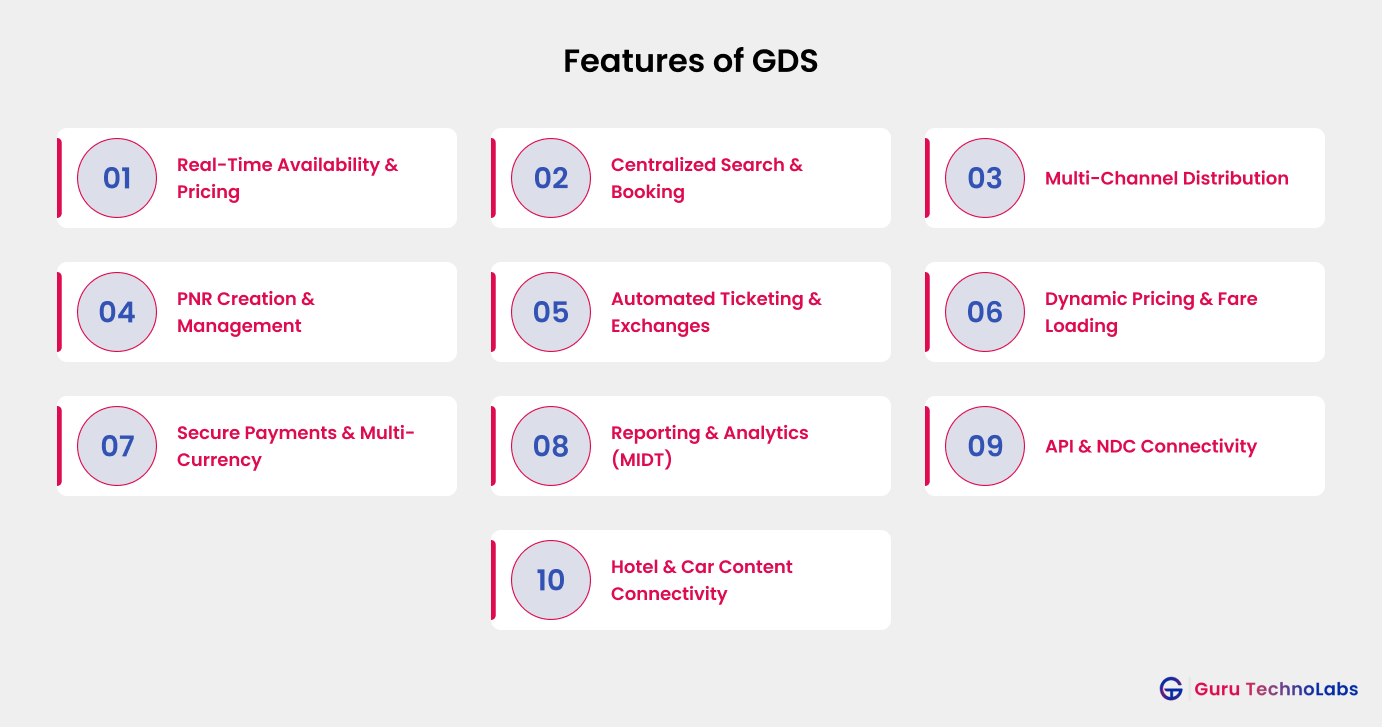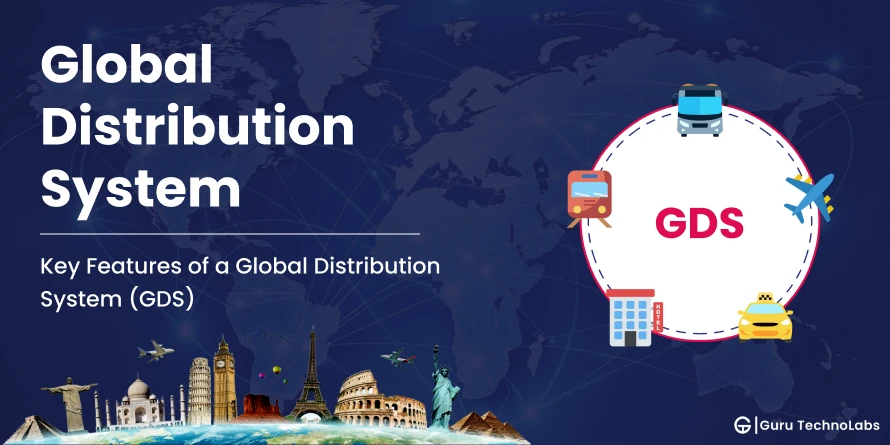A Global Distribution System (GDS) is the backbone of modern travel booking, connecting airlines, hotels, car rental companies, and travel agencies through a single platform. Instead of managing multiple vendor systems, a GDS provides real-time access to fares, room availability, and schedules—all in one place.
In this article, we’ll focus on the key features of a GDS that make it indispensable for the travel industry. From real-time inventory and dynamic pricing to automated ticketing and API connectivity, you’ll see how these capabilities streamline operations for providers and deliver faster, more reliable bookings for travelers.
Core GDS Features

Real-Time Availability & Pricing
A GDS shows up-to-the-minute flight seats, hotel rooms, and car rental options by pulling data directly from suppliers’ CRS (Central Reservation System). It ensures travellers and agents always see what’s available, no stale data or double-bookings.
Example: If an airline removes a seat from inventory or a hotel sells out a room, the update is reflected instantly in the GDS.
Centralized Search & Booking
Instead of switching between multiple supplier platforms, a GDS allows agents and travellers to book flights, hotels, and cars in one place. This centralization reduces errors, saves time, and simplifies even complex itineraries.
Example: A travel agency can combine multiple airlines and hotel chains into a single itinerary with just a few clicks.
Multi-Channel Distribution
With GDS connectivity, travel providers can distribute their content across OTAs, TMCs, airline websites, and traditional agency desktops simultaneously.
Example: The same flight seat or hotel room can be booked through Expedia, a corporate booking tool, or a travel agent, all powered by the same GDS feed.
PNR Creation & Management
Every booking in a GDS generates a Passenger Name Record (PNR) that stores traveller details, itinerary, and payment information. GDS platforms allow agencies to manage PNRs efficiently with queues, updates, and automation.
Example: A corporate travel agent can quickly reissue or modify a PNR when flight schedules change.
Automated Ticketing & Exchanges
GDS systems automate ticket issuance, reissues, refunds, and exchanges. This reduces manual intervention and speeds up customer service.
Example: Once a booking is confirmed, the GDS generates an e-ticket instantly, and any cancellation or refund can be processed through the same platform.
Dynamic Pricing & Fare Loading
Beyond availability, a GDS delivers the latest fare filings, room rates, and promotions through integrations with providers like ATPCO (for airfares) and OAG/Cirium (for schedules). This ensures the displayed prices aren’t just current, but also aligned with dynamic pricing strategies.
Example: Airlines can introduce a flash sale or update seasonal fares, and those changes are visible in the GDS within minutes.
Secure Payments & Multi-Currency
A GDS integrates with BSP/ARC and global payment gateways to process transactions across currencies and markets safely.
Example: A European travel agency can process a booking for a U.S. airline in dollars while charging the customer in euros.
Reporting & Analytics (MIDT)
Modern GDS platforms provide Market Information Data Tapes (MIDT) and advanced reporting tools, helping agencies and suppliers track sales, demand, and performance.
Example: An airline can analyze booking trends across agencies to optimize its route pricing strategy.
API & NDC Connectivity
Today’s GDSs increasingly support APIs and IATA’s New Distribution Capability (NDC), allowing richer content like seat maps, baggage, and ancillaries to be displayed.
Example: Leading providers such as Amadeus, Sabre, and Travelport offer APIs that integrate GDS content into custom booking engines.
Hotel & Car Content Connectivity
Beyond flights, a GDS connects directly to hotel CRS and channel managers, as well as car rental systems, giving agencies access to non-air content in the same booking flow.
Example: A travel agent can book a Hilton hotel room and a Hertz rental car through the same GDS screen while confirming the flight.
GDS Features for Hotels
For hotels, a GDS is more than just a distribution tool; it’s a gateway to higher occupancy and visibility in corporate travel markets. Key features include:
Corporate Travel Visibility
Hotels connected to a GDS are accessible to global corporate booking tools and travel management companies (TMCs), helping them win high-value business travellers.
Rate Loading & Management
Hotels can publish negotiated corporate rates, seasonal promotions, and dynamic pricing directly in the GDS, ensuring agents always see the correct rate plan.
Consortia & Preferred Programs
Through GDS participation, hotels can join global consortia (e.g., American Express, BCD, HRG) to reach premium travel buyers and gain marketing exposure.
GDS Features for Travel Agencies
For travel agencies, a GDS acts as the command centre for building and managing complex itineraries efficiently. Features include:
Multi-Carrier Combinations
Agents can combine multiple airlines into a single itinerary (interlining, codeshares) that would be difficult to book directly through supplier sites.
Queue Management
GDS systems allow agencies to organize PNRs into queues for ticketing, schedule changes, or follow-up tasks, making high-volume management much easier.
Ancillary Services & Upselling
Modern GDSs support ancillaries like seat selection, baggage, meals, or insurance, giving agencies opportunities to upsell.
Commission & Incentive Tracking
GDS platforms often include reporting tools to monitor commissions, overrides, and incentive programs tied to bookings.
Wrapping Up: Why GDS Features Truly Matter
A Global Distribution System is more than a booking platform, it’s the backbone of connectivity in the travel industry. Its features are what make seamless global travel possible.
For hotels, GDS features ensure visibility in corporate markets and access to preferred programs. For travel agencies they provide tools that simplify complex bookings.
Together, these capabilities explain why GDS platforms remain indispensable in modern travel. Understanding their features is the first step toward leveraging them effectively, whether you’re a supplier, an agency, or a technology partner building solutions for the industry.
Frequently Asked Questions
A Global Distribution System provides features like real-time availability, centralized booking, PNR management, multi-channel distribution, dynamic pricing, and secure payments. These capabilities make it the backbone of modern travel booking.
Hotels use GDS platforms to increase visibility in corporate travel markets, manage negotiated rates, participate in global consortia, and display amenities directly to travel agents. This helps boost occupancy and attract high-value business travellers.
A CRS (Central Reservation System) stores a hotel’s or airline’s inventory, while a GDS connects multiple CRSs and distributes that content globally. Unlike a CRS, the GDS itself does not hold inventory, it simply provides access.
Fares and schedules are loaded into a GDS through specialized third-party providers. Airlines file fare data with ATPCO (Airline Tariff Publishing Company), and global schedule information comes from data aggregators like OAG or Cirium. The GDS ingests these feeds in real time, making current fares and flight times available instantly to travel agents and booking platforms.
Amadeus is one of the largest GDS platforms, used worldwide by airlines, hotels, and travel agencies. Its key features include:
- Comprehensive global air, hotel, and rail inventory.
- Advanced search and fare comparison tools.
- Strong NDC (New Distribution Capability) integration for richer airline content.
- APIs for custom booking solutions and online travel agencies.
- Robust data analytics and revenue management tools.
Sabre is another major GDS, with a strong presence in North America and global reach. Its features include:
- Access to air, hotel, cruise, and car rental content.
- Efficient PNR creation and management for agencies.
- Automated ticketing and exchange processes.
- API and NDC connectivity for modern retailing.
- Mid- and back-office integration tools for agencies and TMCs.
Travelport (which includes Galileo, Apollo, and Worldspan) is known for its flexible distribution technology. Its key features include:
- Extensive global air, hotel, and car rental coverage.
- Rich content display for ancillaries and branded fares.
- Powerful APIs (Travelport+ platform) for developers and OTAs.
- Multi-channel distribution to agencies, TMCs, and OTAs.
- Real-time payments and integrated business intelligence tools.
Explore more on - Travelport API Integration
















